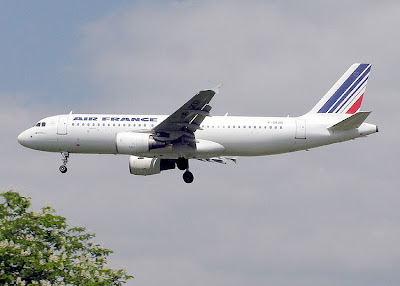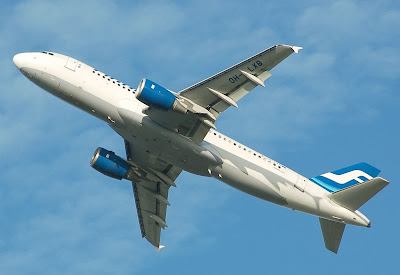 The Airbus A320 family of short-to-medium range commercial passenger aircraft are manufactured by Airbus S.A.S.. Family members include the A318, A319, A320, and A321, as well as the ACJ business jet. First delivered in 1988, the A320 pioneered the use of digital fly-by-wire flight control systems in a commercial aircraft. With 3000 variants of the A320 family built, it is the second best selling jet airliner family of all time, after the family's primary competition, the Boeing 737.
The Airbus A320 family of short-to-medium range commercial passenger aircraft are manufactured by Airbus S.A.S.. Family members include the A318, A319, A320, and A321, as well as the ACJ business jet. First delivered in 1988, the A320 pioneered the use of digital fly-by-wire flight control systems in a commercial aircraft. With 3000 variants of the A320 family built, it is the second best selling jet airliner family of all time, after the family's primary competition, the Boeing 737.
Airbus A320 Background
After the initial success of the A300, Airbus began developing a new model aimed at replacing the world's most popular aircraft at the time, the Boeing 727. The new Airbus would be of the same size, yet offer improved operating economics and various passenger capacities. The digital technology in the A320 would herald a two-generation technological leap over the all-analog Boeing 727 and be a generation ahead of the Boeing 737-300/-400/-500 series. The A320 was targeted at the global fleet replacement requirements for the 727 and early variants of the 737. A bmi A320-200
A bmi A320-200
After the oil price rises of the 1970s, Airbus needed to minimise the trip fuel costs of the A320. To that end, Airbus incorporated advanced features including fly-by-wire flight control, composite primary structures, centre-of-gravity control using fuel, glass cockpit (EFIS) and a two-person flight deck. The end result was that the A320 consumes 50% less fuel than the 727.
Airbus A320 Production
Components from various Airbus plants are transported to the final assembly plant at Hamburg Finkenwerder for the A318/A319/A321 and to Toulouse Blagnac for the A320. Nearly all assemblies are moved using Airbus' A300-600ST 'Beluga' outsized transporters.
The Airbus A320s sold to China to be delivered between 2009 and 2012 will be assembled in the People's Republic of China in Tianjin. Airbus intends to relocate Toulouse A320 final assembly activity to Hamburg as part of its Power8 organization plan begun under ex-CEO Christian Streiff.
The A320 family has the highest production rate ever for any commercial airliner. In response to continuing strong demand, Airbus continues its steady production ramp-up programme from 30 aircraft per month reached at the end of 2006, to 32 in early 2007, 34 in March 2008, 36 in December 2008, 38 in mid 2009 and 40 by the end of 2009. Tianjin production is included in these numbers.
Airbus A320 Design
Compared to other airliners of the same class, the A320 features a wider single-aisle cabin and larger overhead bins along with fly-by-wire technology. In addition, the aircraft has a spacious cargo hold equipped with large doors to assist in expedient loading and unloading of goods. These features have resulted in orders from airlines including Northwest Airlines (launch customer for United States), United Airlines, and British Airways. The A320's low maintenance and operating costs have appealed to low-cost carriers, as well. JetBlue, for example, has orders and options for up to 233 jets of the A320 family. Other low-cost carriers with significant orders include Kingfisher Airlines, IndiGo Airlines, EasyJet, Frontier Airlines, Tiger Airways, Cebu Pacific Air and AirAsia.
The A320 features a computerised on-board maintenance system. The avionics system is designed for easy upgrade without major rework. With the exception of the very earliest A320s, most can be upgraded to the latest avionics standards, keeping the aircraft advanced even after almost 2 decades in service.
The flight deck is equipped with EFIS with sidestick controllers. At the time of the aircraft's introduction, the behavior of the fly-by-wire system (equipped with full flight envelope protection) was a new experience for many pilots. Rigorous pilot training and modification of the fly-by-wire system has greatly reduced incidents related to the EFIS system.
Two suppliers provide turbofan engines for the A320 series: CFM International with their CFM56, and International Aero Engines, offering the V2500.
Airbus A320 Technology
Technology used in the A320 includes:
* The first fully digital fly-by-wire flight control system in a civil airliner.
* Fully glass cockpit rather than the hybrid versions found in A310, Boeing 757 and Boeing 767
* The first narrowbody airliner with a significant amount of the structure made from composites
* The ECAM (Electronic Centralized Aircraft Monitoring) concept, which is included in all Airbus aircraft produced after the A320. This system constantly displays information concerning the aircraft's engines, as well as other key systems such as flight controls, pneumatics and hydraulics, to the pilots on the two LCD displays in the centre of the flightdeck.
* Airbus recently has started installing LCD (liquid crystal) display units in the flight deck of its new A318, A319, A320, and A321 flight decks instead of the original CRT (cathode ray tube) displays. These include the main displays and the backup artificial horizon, which was an analog display prior to this. LCDs weigh less and produce less heat than CRT displays.
* Even though the A320 family is technologically advanced, the computers at the heart of the aircraft are built around CPUs roughly equivalent to the Intel 8086. While these chips may not offer anywhere near the power of modern processors, they are incredibly stable, and allow engineers to examine literally decades of information related to their operation.
Airbus A320 New winglets
In 2006, Airbus tested three styles of winglet, intended to counteract the wing’s induced drag and wingtip vortices more effectively than the previous wingtip fence. Adoption of the new winglets was expected to reduce fuel consumption by one to two percent. The first design type to be tested was developed by Airbus and was based on work done by the AWIATOR program. The second type of winglet used a more blended design and was created by Winglet Technology LLC, a company based in Wichita, Kansas as well as the third type.
Two airplanes were used in the flight test evaluation campaign. F-WWBA, the first A320 produced, has been retained by Airbus for testing, and was fitted with both the first type and second type of winglets. JetBlue Airways provided the second aircraft, retrofitted by Airbus with both types of winglet.
Despite the anticipated efficiency gains and development work, Airbus announced that the new winglets will not be offered to customers, claiming that the weight of the modifications required would negate any aerodynamic benefits. In addition, the change in forces from winglets add additional stress to the wing which would require long-term study to determine if structural integrity is compromised.
Operational service
The JAA issued the type certificate for the A320 on 26 February 1988. After entering the market in March 1988 with Air France, Airbus expanded the A320 family rapidly, launching the 185-seat A321 in 1989, the 124-seat A319 in 1993, and the 107-seat A318 in 1999. An Airbus A320 of Air Blue in Karachi
An Airbus A320 of Air Blue in Karachi
The A320 family was developed to compete against the Boeing 737 Classics (-300/-400/-500) and the McDonnell Douglas MD-80/90 series, and has since faced challenges from the Boeing 737 Next-Generation (-600/-700/-800/-900) and the Boeing 717 during its almost two decades in service. As of February 2006, the only remaining competitor to the larger A320 variants is the Boeing 737 Next-Generation series, as the other models have ceased production. Embraer's 195 jet is also a major competitor to the A318.
Airbus has shipped 3,092 A318/A319/A320/A321s since its certification/first delivery in early 1988, with another 1,984 on firm order (30 April 2007). Boeing has shipped 5,379 737s since late 1967 with a further 1,557 on firm order (30 April 2007). Based on these figures Airbus delivered on average 160 A320 series aircraft per annum, compared to 133 for Boeing's 737.
Airbus is studying a replacement for the A320 series, tentatively dubbed NSR, for "New Short-Range aircraft. The planform of an A320 is well shown on this Finnair A320-200 takeoff
The planform of an A320 is well shown on this Finnair A320-200 takeoff
Source: Wikipedia
June 06, 2007
Airbus A320
Labels: Aircraft List
Subscribe to:
Post Comments (Atom)






No comments:
Post a Comment